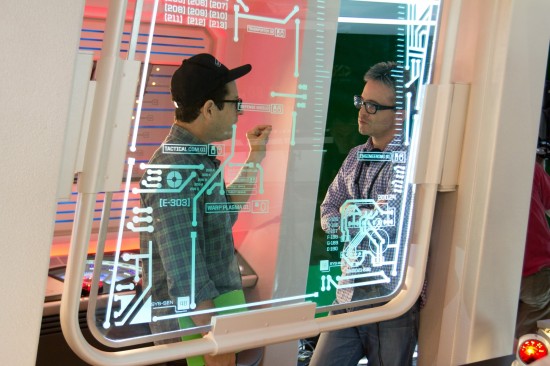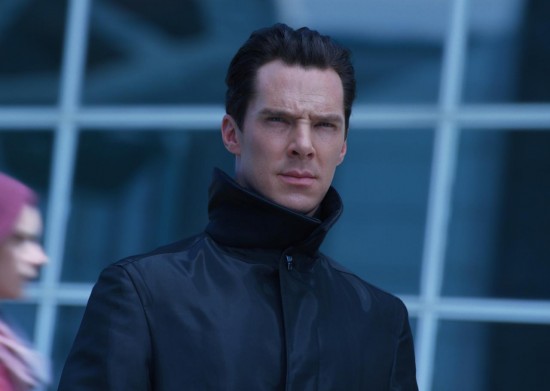J.J. Abrams Created An Alternate Scene To Preserve The Secret Of 'Star Trek Into Darkness'
Stardate December 10, 2012. A group of journalists are invited to Bad Robot in Santa Monica, CA to learn a little bit more about J.J. Abrams' Star Trek Into Darkness. At this time everyone was still unclear who, exactly, Benedict Cumberbatch was playing in the film. Rumors about his character were relentless. To cut the question off at the pass, Abrams himself led everyone into a screening room to show some footage. He explained this was footage no one would see again for several months, we shouldn't tell anyone we saw it, but it would clear some things up.
With Star Trek Into Darkness now in theaters, it's time to talk about that footage because what we saw and what's now playing are very, very different. This change exemplifies not only the lengths Abrams went to preserve the theatrical film experience, but it opens up the discussion for exactly why secrecy was so important.
Spoilers abound from here on out.
The scene in question was the space jump, which takes in the middle of act two and features Cumberbatch's character and Captain Kirk shooting through space towards the another starship. It's an exciting action sequence that included two distinctly unforgettable moments. The first was a readout on the Enterprise bridge clearly stating "Harrison" as the character's name. The second was Spock clearly saying the name "Harrison." Twice. Not so coincidentally, this was the same day Paramount released this photo revealing the character's name: John Harrison. The rest of the day, the question of who Cumberbatch was playing never in doubt. He wasn't Khan, just John.
Fast forward six months. Star Trek Into Darkness is now in theaters and you've seen the space jump scene...with two distinct differences. The names were changed to protect the innocent. Yes, J.J. Abrams went out of his way to create dialogue and visuals general audiences would never see simply to fool us about the true identity of the character. It's just one of many examples of how he and his team used misdirection to both preserve the theatrical experience and wink at the rabid fans.
Before we continue, I want to make clear I'm not mad at J.J. Abrams and Star Trek Into Darkness crew for doing this. In fact, I applaud it. The extra effort shows an incredible desire to surprise the audience, which is something that can be very difficult to do in today's information-heavy society. The fact that the director went out of his way to provide us with alternate information, instead of just filling a trailer with reveal after reveal, is a true testament to how important these kind of things are.
In the film, the scene in question happens after Cumberbatch's character reveals he's not John Harrison, but Khan, a genetically engineered superhuman with an agenda against Starfleet. (Khan is one of the most iconic characters in Star Trek lore and the person most people assumed Cumberbatch was playing.) Spock refers to him as "Khan" twice in the scene and the name, "Khan," is clearly displayed on the screen. These were 100% different from the sequence when it screened in December, again at CinemaCon in April and possibly other places.
"[Producer] Bryan Burk was the one who first proposed that we use the space jump sequence as a way of getting folks excited for the movie," explained Star Trek Into Darkness producer and co-writer Damon Lindelof. "The challenge was obvious [because] this is AFTER the reveal. Therefore, J.J. and post production supervisor Ben Rosenblatt executed a "Harrison Cut" to preserve the secret. I'd rather not get into the details of how this was accomplished, suffice to say it wasn't easy. It was, however, worth it."

This wasn't the first time Abrams and his crew created a ruse to preserve this secret. Abrams said early reports of the character were "Not True." Simon Pegg specifically said the character was not Khan. Karl Urban told everyone the character was Gary Mitchell. But honestly, what were they going to say? "Yup, you got us. It's Khan. We're going to give up that surprise a year out." They can't.
"The preservation of Harrison's identity has been on ongoing and evolving strategy since the moment we decided to go down the road we went down," Lindelof said. "Before we even started shooting the movie, we acknowledged that there was a fine line between cryptic avoidance and outright denial. We never wanted to overtly lie, but agreed that a certain degree of misdirection wasn't only warranted, but necessary."
The question than becomes, why make it a secret in the first place? Doesn't it seem feasible that including a well-known villain like Khan would attract more fans to the film? Burk says that the reveal became organic in the development of the story:
The characters believe he is one person: John Harrison. If everything you know going into the movie is "It's a guy named Khan," even if you don't even know who Khan is, you know that you're watching a film where for forty-five minutes or an hour of the movie you are ahead of the characters. So you're just kind of waiting for them to catch up with what you already know, that he is not who he says he is. So there's the general idea of going to see a movie and allowing it to unfold as it normally does.
Lindelof then added, in addition to the reveal servicing the story, it also accounts for decades of Star Trek preconceptions. "The story most people are engaged in and know is Wrath of Khan, but a lot of people don't know about Space Seed, which was the origin story for that character and that happens to be the time and space in which our movie was taking place," Lindelof said. "We knew if the Enterprise came across The Botany Bay, the audience would know something the Bridge crew did not, which was 'Whatever you do, don't wake that dude up.' So we didn't want to put the Bridge crew behind the audience in terms of what they knew about Trek."
Their personal Trek fandom is also essential to another interesting aspect of Bad Robot handled this reveal. Whether they like to admit it or not, they used every opportunity to dangle Cumberbatch's identity over our heads knowing, as fans, we love the hunt.
Who can forget the foreign teaser trailer featuring the iconic hand on the glass shot from Wrath of Khan, more or less teasing audiences that the film has a Khan twist? Then there's the alternative edit of the film's opening.

In December, Paramount released the first few minutes of Into Darkness with IMAX prints of The Hobbit. At the time, the footage began with the scene involving Noel Clarke's character Harewood. Despondent and thinking his daughter is going to die, a mysterious character promises he can help. It's here we get our first reveal of Harrison in an IMAX close up with the line of dialogue "Who are you?" It was an edge of your seat moment six months before release because we thought Harrison might actually answer.
In the final film, that scene now comes after the opening title, 10 minutes later. It almost feels like the question "Who are you?", strategically placed right at the beginning of this fan preview, was moved there specifically to mess with audiences craving answers. Not the case, says Lindelof:
The "who are you?" scene always came first in script... but when we saw a cut of the movie, it became clear that we should start with the action on Nibiru. However, when it came to crafting the IMAX preview on The Hobbit, we all agreed that the more exciting "cliffhanger" would be to go out on Spock inside the volcano, about to get incinerated, thus restoring the continuity from the script, albeit temporarily.
Or maybe he's just messing with us. Maybe last year, in an editing suite at the Bad Robot offices, Abrams and his team were laughing about the look on people's faces thinking they'd get the answers they seek, and then pulling the rug out for under them. It's pretty obvious they'll go to unprecedented lengths to preserve a secret and make us beg for more. In an era where every trailer gives away many surprises, this kind of dedication, passion, and yes – misdirection – is a good thing.
